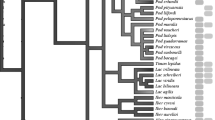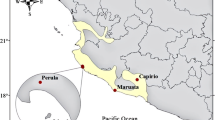Abstract
Interspecific chemical variation of precloacal pore secretions of Liolaemus lizards was characterized in 20 species, and intraspecific chemical variation was characterized using nine individuals of L. bellii. The latitude (Chile, 18° to 33° South latitude) and altitude (100 to 4350 m.a.s.l.) of the capture sites were recorded, as well as the number of precloacal pores of each lizard. Secretions were analyzed by GC-MS. A total of 49 compounds were found distributed among the 20 species of Liolaemus. Different chemical patterns occurred at intra- and interspecific levels. Compounds belonged to three main families: n-alkanes, long chain carboxylic acids, and steroids. Cholesterol and five carboxylic acids (tetradecanoic, hexadecanoic, hexadecenoic, octadecanoic, and Z-9-octadecenoic) appeared in all species. The number of precloacal pores correlated positively with altitude and negatively with latitude, suggesting that lizards produce more secretions under harsh environments.
Similar content being viewed by others
REFERENCES
AHERN, D. G., and DOWNING, D. T. 1974. Skin lipids of the Florida indigo snake. Lipids 9:8–14.
ALBERTS, A.C. 1990. Chemical properties of femoral gland secretions in the desert iguana, Dipsosaurus dorsalis. J. Chem. Ecol. 16:13–25.
ALBERTS, A.C. 1991. Phylogenetic and adaptive variation in lizard femoral gland secretions. Feromonal self-recognition in desert iguanas. Copeia 1991:69–79.
ALBERTS, A. C. 1992. Pheromonal self-recognition in desert iguanas. Copeia 1992:229–232.
ALBERTS, A. C., PHILLIPS, J. A., and WERNER, D. I. 1993. Sources of intraspecific variability in the protein composition of lizard femoral gland secretions. Copeia 1993:775–781.
ALBERTS, A. C., SHARP, T. R., WERNER, D. I., and WELDON, P. J. 1992. Seasonal variation of lipids in femoral gland secretions of male green iguanas (Iguana iguana). J. Chem. Ecol. 18:703–712.
ANTONIAZZI, M. M., JARED, C., PELLEGRINI, C. M. R., and MACHA, N. 1993. Epidermal glands in Squamata: Morphology and histochemistry of the precloacal glands in Amphisbaena alba (Amphisbaenia). Zoomorphology (Berlin) 113:199–203.
ANTONIAZZI, M. M., JARED, C., and JUNQUEIRA, L. C. U. 1994. Epidermal glands in Squamata: fine structure of pre-cloacal glands in Amphisbaena alba (Amphisbaenia, Amphisbaenidae). J. Morphol. 221:101–109.
BULL, M. C., GRIFFIN, C. L., and PERKINS, V. 1999. Some properties of a pheromone allowing individual recognition, from the scats of an Australian lizard, Egernia striolata. Acta Ethologica 2:35–42.
BURKEN, R. R., WERTZ, P. W., and DOWNING, T. D. 1985. A survey of polar and nonpolar lipids extracted from snake skin. Biochem. Physiol. 81B:315–318.
CHAUHAN, N. B. 1986a. Histological and structural observations on pre-anal glands of the gekkonid lizard, Hemidacttylus flaviviridis. J. Anat. 144:93–98.
CHAUHAN, N. B. 1986b. A preliminary report on the lipid components of pre-anal gland secretion of lizards Hemidactylus flaviviridis and Uromastix hardwickii. J. Anim. Morphol. Physiol. 33:73–76.
COOPER, W. E. 1996. Chemosensory recognition of familiar and unfamiliar conspecifics by the scincid lizard Eumeces laticeps. Ethology 102:454–464
COOPER, W. E. 1998. Evaluation of the swap and related tests as a bioassay for assessing responses by squamata reptiles to chemical stimuli. J. Chem. Ecol. 24:841–866.
COOPER, W. E., and GARSTKA, W. R. 1987. Lingual responses to chemical fractions of urodaeal glandular pheromones of the skink Eumeces laticeps. J. Exp. Zool. 242:249–253.
COOPER, W. E. J., LÓPEZ, P., and SALVADOR, A. 1994. Pheromones detection in amphisbaenian. Anim. Behav. 47:1401–1411.
COOPER, JR., W. E., VAN WYK, J. H., and MOUTON, P. LE F. N. 1996. Pheromonal detection and sex discrimination of conspecific substrate deposits by the rock-dwelling cordylid lizard, Cordylus cordylus. Copeia 1996:839–845.
DONOSO-BARROS, R. 1966. Reptiles de Chile. Editorial Universitaria, Universidad de Chile, Santiago, Chile. 458 pp.
ETHERIGDE, R. 1995. Redescription of Ctenoblepharys adspersa Tschudi, 1845, and the taxonomy of Liolaeminae (Reptilia: Squamata: Tropiduridae). Amer. Mus. Novitates 3142:1–34.
FONT, E. 1996. Los sentidos químicos de los reptiles. Un enfoque etológico, pp. 197–259, in Colmenares, F. (ed.). Etología, Psicología Comparada y Comportamiento Animal. Madrid: Síntesis Psicológica. Editorial Síntesis S. A.
GRAVES, B. M., and HALPERN, M. 1991. Discrimination of self from conspecific chemical cues in Tiliqua scincoides (Sauria: Scincidae). J. Herpetol. 25:125–126.
JARED, C., ANTONIAZZI, M. M., SILVA, J. R. M. C., and FREYMULLER, E. 1999. Epidermal glands in squamata: Microscopical examination of precloacal glands in Amphisbaena alba (Amphisbaenia, Amphisbaenidae). J. Morphol. 241:197–206.
LABRA, A., and NIEMEYER, H. M. 1999. Intraspecific chemical recognition in the lizard Liolaemus tenuis. J. Chem. Ecol. 25:1799–1811.
LABRA, A., BELTRáN, S., and NIEMEYER, H. M. 2001. Chemical exploratory behavior in the lizard Liolaemus bellii. J. Herpetol. (in press)
LÓPEZ, P., SALVADOR, A., and COOPER, JR., W. E. 1997. Discrimination of self from other males by chemosensory cues in the amphisbaenian Blanus cinereus. J. Comp. Psych. 111:105–109.
MANLY, B. F. J. 1994. Multivariate Statistical Methods. A Primer. Chapman & Hall, London.
MARTíN, J., and LÓPEZ, P. 2000. Chemoreception, symmetry and mate choice in lizards. Proc. R. Soc. Lond. B267:1265–1269.
MARTINS, E. P., and HANSEN, T. F. 1996. The statistical analysis of interspecific data: a review and evaluation of phylogenetic comparative method, pp. 22–75, in E. Martins (ed.). Phylogenies and the Comparative Method in Animal Behavior. Oxford University Press, Oxford.
MASON, R. T. 1992. Reptilian pheromones, pp. 114–228, in C. Gans, and D. Crews (eds.). Hormones, Brain and Behavior. Biology of Reptilia, Vol 18 E. The University Chicago Press, Chicago.
MASON, R. T. 1999. Integrated pest management: The case for pheromonal control of habu (Trimeresurus flavoviridis) and brown tree snakes (Boiga irregularis), pp. 196–205, in G. H. Rodda, Y. Sawai, D. Chiszar, and H. Tanaka (eds.). Problem Snake Management: the Habu and the Brown Tree Snake. Cornell University Press.
MASON, R. T., FALES, H. M., JONES, T. H., PANNELL, L. K., CHINN, J. W., and CREWS, D. 1989. Sex pheromones in snakes. Science 245:290–293.
MASON, R. T., and GUTZKE, W. H. N. 1990. Sex recognition in the leopard gecko, Eublepharis macularius (Sauria: Gekkonidae) possible mediation by skin-derived semiochemicals. J. Chem. Ecol. 16:27–36.
NICOLAIDES, N. 1974. Skin lipids: their biochemical uniqueness. Science 186:19–26.
PESYNA, G. M., VENKATARAGHAVAN, R., DAYRINGER, H. E., and MCLAFFERTY, F. W. 1976. Probability based matching system using a large collection of reference mass spectra. Anal. Chem. 48:1362–1368.
SCHULTE, J. A., MACEY, J. R., ESPINOZA, R. E., and LARSON, A. 2000. Phylogenetic relationships in the iguanid lizard genus Liolaemus: multiple origins of viviparous reproduction and evidence for recurring Andean vicariance and dispersal. Biol. J. Linnean Soc. 69:75–102.
WELDON, P. J., and BANGALL, D. 1987. A survey of polar and nonpolar skin lipids from lizards by thin-layer chromatography. Comp. Biochem. Physiol. 87B:345–349.
WELDON, P. J., DUNN, B. S., MCDANIEL, C. A., and WERNER, D. I. 1990. Lipids in the femoral gland secretions of the green iguana (Iguana iguana). Comp. Biochem. Physiol. 95B:541–543.
ZAR, J. H. 1984. Biostatistical Analysis. Prentice-Hall International, Englewood Cliffs, New Jersey, 718 pp.
Author information
Authors and Affiliations
Rights and permissions
About this article
Cite this article
Escobar, C.A., Labra, A. & Niemeyer, H.M. Chemical Composition of Precloacal Secretions of Liolaemus Lizards. J Chem Ecol 27, 1677–1690 (2001). https://doi.org/10.1023/A:1010470611061
Issue Date:
DOI: https://doi.org/10.1023/A:1010470611061




